European Accessibility Act (EAA) resources
Required reading and expert insight at the ready for all your digital accessibility needs.
Talk to an EAA specialist
Must-have EAA compliance resources

Following high interest and attendance at our first two webinars in the EAA series, we closed with a session that delivered exactly what you asked for: real-world examples from an organization already leading the way.
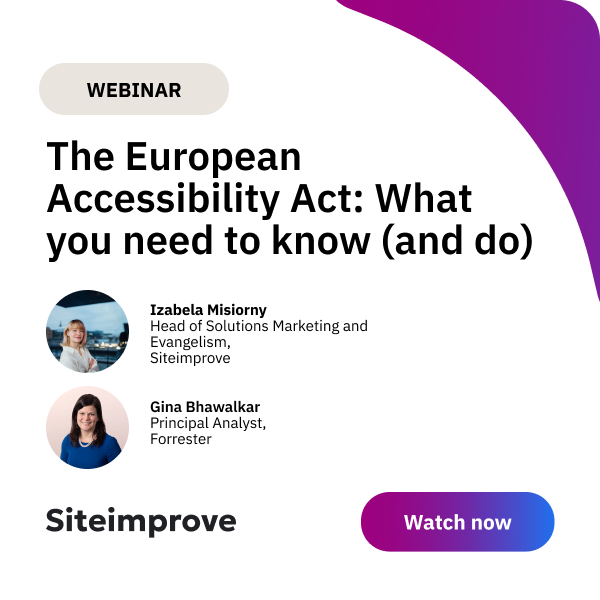
Stay informed and confidently navigate your EAA compliance journey with clear, actionable guidance from our accessibility experts.
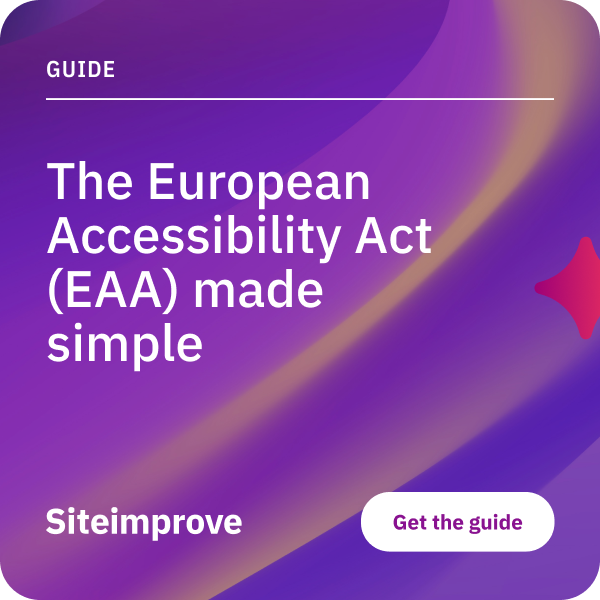
Overwhelmed by technical jargon and acronyms? We're here for you with straightforward insights.
Become more fluent in the EAA
How to achieve EAA compliance
This resource provides a list of basic requirements, from semantic structure to security.
EAA FAQs
Ensure you thoroughly understand the EAA requirements for your business and are fully prepared to make any adjustments you need to make.
Essential steps for B2B
EAA applies to just about every company, no matter the region.
Everything you need to know about EAA
Any business that trades in the EU will need to comply with the European Accessibility Act (EAA). Make sure you know what you need to prepare.
EAA must-reads
We've compiled a list of our own resources that can help you understand what's expected and how to meet the requirements.
Mastering EAA implementation
Here's a simple framework to help you create and carry out effective EAA strategies.
How Siteimprove helps you comply
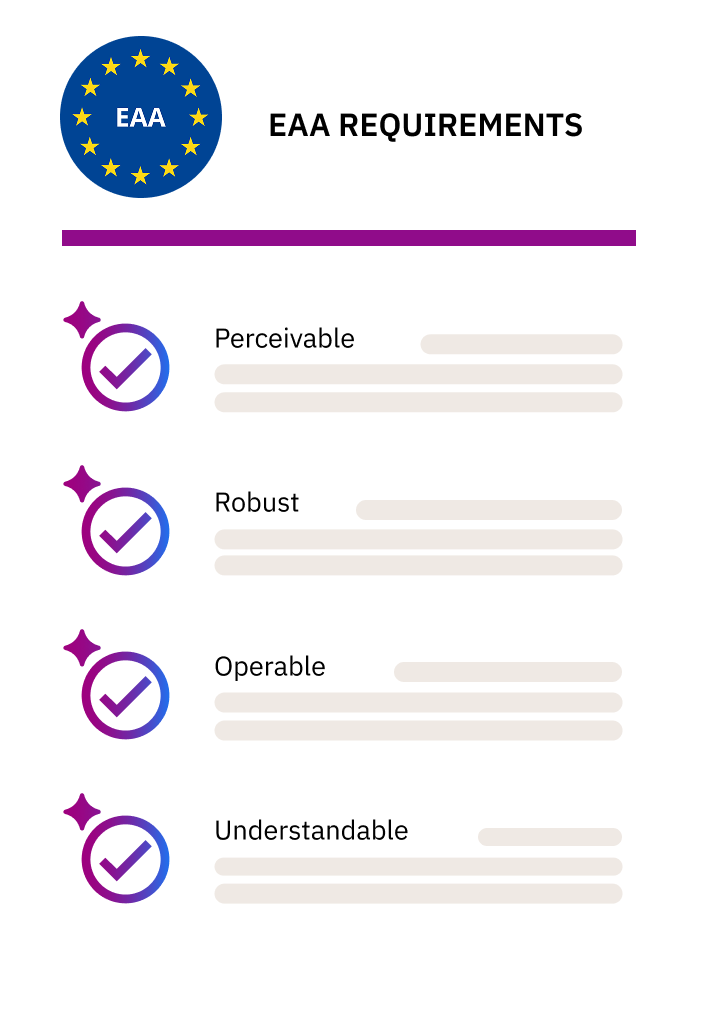
European Accessibility Act (EAA) FAQs
Q: What is the EAA and who does it apply to?
A: The European Accessibility Act (EAA) comes into effect on June 28, 2025. It applies to private businesses operating in the EU with over 10 employees and annual turnover above €2M. It mandates accessibility across digital products and services, and consumers can file a complaint if they feel the company isn't meeting the rules. Penalties vary by country and can be up to €3 million.
Q: What if we are based outside the EU?
A: If your business markets to or serves users in the EU, the EAA applies, regardless of your HQ location.
Q: What sectors and products are affected?
A: The EAA impacts a wide range:
- Products: Websites, mobile apps, POS devices, e-readers, ticketing machines, etc.
- Industries: Retail, banking, healthcare, education, telecommunications, and more.
Q: What accessibility standard does the EAA require?
A: The EAA references EN 301 549, which incorporates WCAG 2.1 AA as the web standard. WCAG 2.2 is not yet required but recommended for future-proofing.
Q: Is WCAG 2.2 AA acceptable for compliance?
A: Yes. WCAG 2.2 includes and builds on WCAG 2.1. While not currently mandated by EN 301 549, it is a smart target.
Q: What about EN 301 549 criteria beyond WCAG?
A: These include additional requirements (e.g., documents, multimedia). Compliance can be complex and may vary by country. When in doubt, consult accessibility experts or local regulations.
Q: What is the transition period for compliance?
A: Content published before June 28, 2025 must comply by June 28, 2030. Any new content after June 28, 2025 must comply from launch.
Q: What accessibility score is "good enough" to avoid penalties?
There is no set "score." Full compliance with WCAG 2.1 AA is expected. While more than 80 percent automated checks are a good internal target, manual testing is essential. Regulators may still act on individual complaints.
Q: Is keyboard navigation required?
A: Yes. It is a core WCAG 2.1 AA requirement and essential for EAA compliance.
Q: Are ARIA roles required?
A: ARIA roles aren't mandatory but help meet many WCAG success criteria and are considered best practice.
Q: Is screen reader testing required, or are automated checks enough?
A: Automated accessibility tools catch many issues, but manual testing remains essential, particularly using assistive technologies like screen readers and keyboard navigation. A hybrid approach-automated checks + expert/manual audits is required to ensure full compliance with both the letter and spirit of the EAA.
Note: Accessibility overlays, a type of software for automation, will not ensure that your site is fully compliant. Any claims that suggest that they will catch and fix all accessibility issues are erroneous.
Q: Can accessibility standards differ by country within the EU?
A: Yes. While the EAA provides a harmonized baseline across the EU, individual member states may adopt stricter requirements or differ in their interpretations of EAA. If your organization operates across several countries, it's best to comply with the most rigorous applicable standard to avoid risk.
Q: Will we need to be fully 100% accessible to pass EAA inspections?
A: The EAA expects full compliance with WCAG 2.1 AA (or EN 301 549). Regulators do not publish a tolerance level for non-compliance; partial compliance does not guarantee protection from complaints or penalties. However, demonstrating documented efforts — including audits, ongoing remediation, staff training, and governance policies — can help show good-faith compliance and reduce risk exposure.
Q: How does the EAA affect B2B companies?
A: While B2B isn't explicitly mentioned, procurement expectations are rising. If your clients or customers are required to comply, they will likely require accessible tools from you.
Q: Does the EAA apply to B2B-only industries, like insurance or industrial manufacturing?
A: Yes, if their services fall within scope (e.g., banking, e-commerce) or if their public-facing sites provide product or service info.
Q: What if we use third-party platforms?
A: You are responsible for accessibility if third-party services are part of your customer journey. Add accessibility clauses in vendor contracts.
Q: What level of accessibility is needed in higher education or public sector?
A: Many are already aligned with WCAG 2.1 under national law. The EAA introduces additional obligations if you're in the private sector or operate cross-border.
Q: Are social media posts covered?
A: Social platforms themselves are not directly covered, but your content should follow best practices (e.g., alt text, captions) for brand consistency and user experience.
Q: Do multilingual sites need alt text in each language?
A: Yes. Alt text and other accessible elements should be localized to match the language of the page.
Q: Do PDFs and downloadable documents need to comply?
A: Yes, if they are public-facing. Use accessible PDF formats and test using screen readers.
Q: Does the EAA apply to intranets and internal systems?
A: The EAA primarily targets public-facing products and services, but internal systems may fall under scrutiny if they’re integral to service delivery (e.g., tools used by frontline employees in banking or customer service). Accessible internal systems also improve employee productivity and inclusion.
Q: Is voiceover or audio description required for videos?
A: If a video conveys visual information that’s not present in the audio, an audio description is required. Closed captions and transcripts are also essential. This ensures your content meets WCAG 2.1/2.2 and EN 301 549 accessibility expectations.
Q: Does Siteimprove support EAA compliance?
A: Yes. While the platform doesn't yet have a dedicated "EAA" flag, Siteimprove audits for WCAG 2.1 AA, which is the core web standard under the EAA.
Q: Will Siteimprove release an EAA dashboard or report?
A: This is under consideration and development. In the meantime, use WCAG settings and reporting to guide your compliance journey.
Q: Can Siteimprove handle non-indexable pages?
A: Yes. Submit a support ticket to tailor your configuration to audit non-indexable content.
Q: How much of EN 301 549 does Siteimprove cover?
A: Siteimprove covers all WCAG 2.1 AA success criteria and some additional EN 301 549 elements, especially for web content.
Q: Can AI make PDFs or InDesign documents accessible?
A: AI tools can assist, but full compliance typically requires manual checks and remediation. Siteimprove and Adobe tools can help.
Q: What are the first steps toward EAA compliance?
A: Use this 10-step process:
- Understand the requirements (EN 301 549 + WCAG)
- Conduct a current-state audit
- Develop internal policies
- Train teams
- Integrate accessibility into design/dev
- Implement fixes
- Monitor compliance
- Document your efforts
- Engage users and stakeholders
- Stay current with evolving standards
Q: What level of compliance is expected by the deadline?
A: WCAG 2.1 AA for web content is the baseline under EN 301 549.
Q: Why does accessibility matter beyond compliance?
A: Accessibility enhances customer experience, brand trust, and operational efficiency. Siteimprove customers have reported up to a 23 percent increase in revenue by ensuring their websites are accessible to all users. This is because an accessible website not only boosts traffic but also enhances user experience, ultimately leading to higher conversions.
Q: Should we have an accessibility policy?
A: It’s not legally required but recommended. It demonstrates accountability and signals commitment.
Q: Is there going to be a WCAG 3.0?
A: WCAG 3.0 is in the works, but no date for release has been issued yet.
Q: How can we get buy-in from our editors and teams to prioritize accessibility?
A: Making accessibility part of everyday work requires leadership support, training, and embedding accessibility into content governance. Use pre-publish accessibility checklists and ensure that accessibility expectations are built into editorial workflows and publishing guidelines. Regular training and sharing real-world examples of how accessibility improves user experience can help shift mindsets. Leadership sponsorship is often the key driver for lasting adoption.
Q: What advice would you give smaller organizations (20–50 employees) trying to meet EAA compliance?
Start by focusing on your most visible and highest-risk content first — typically your homepage, key customer journeys, forms, and public PDFs. Use automated tools like Siteimprove to establish a baseline and prioritize issues. Assign accessibility responsibility within existing teams, even if no full-time role exists. As capacity grows, gradually expand manual audits and remediation efforts.
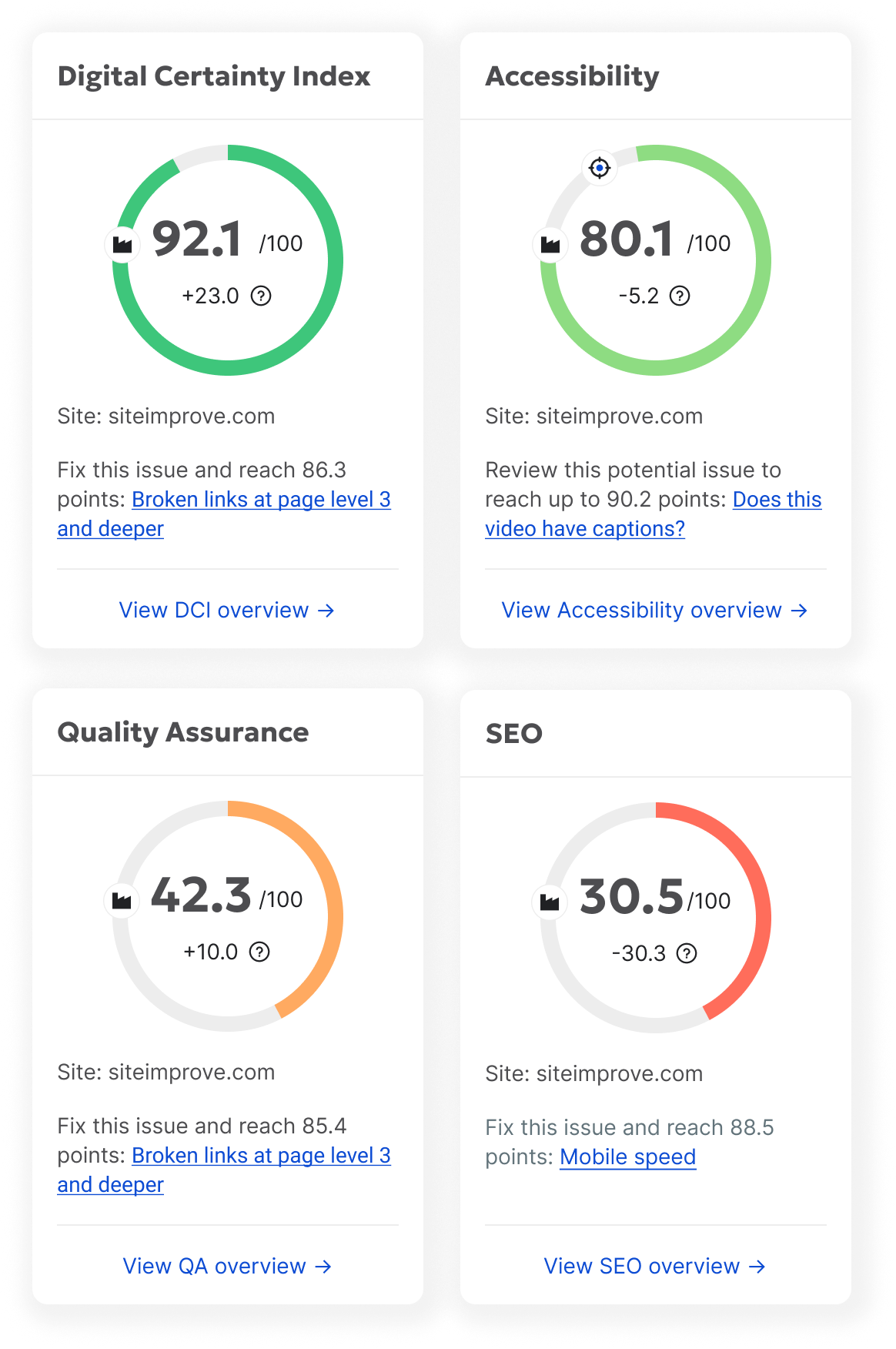
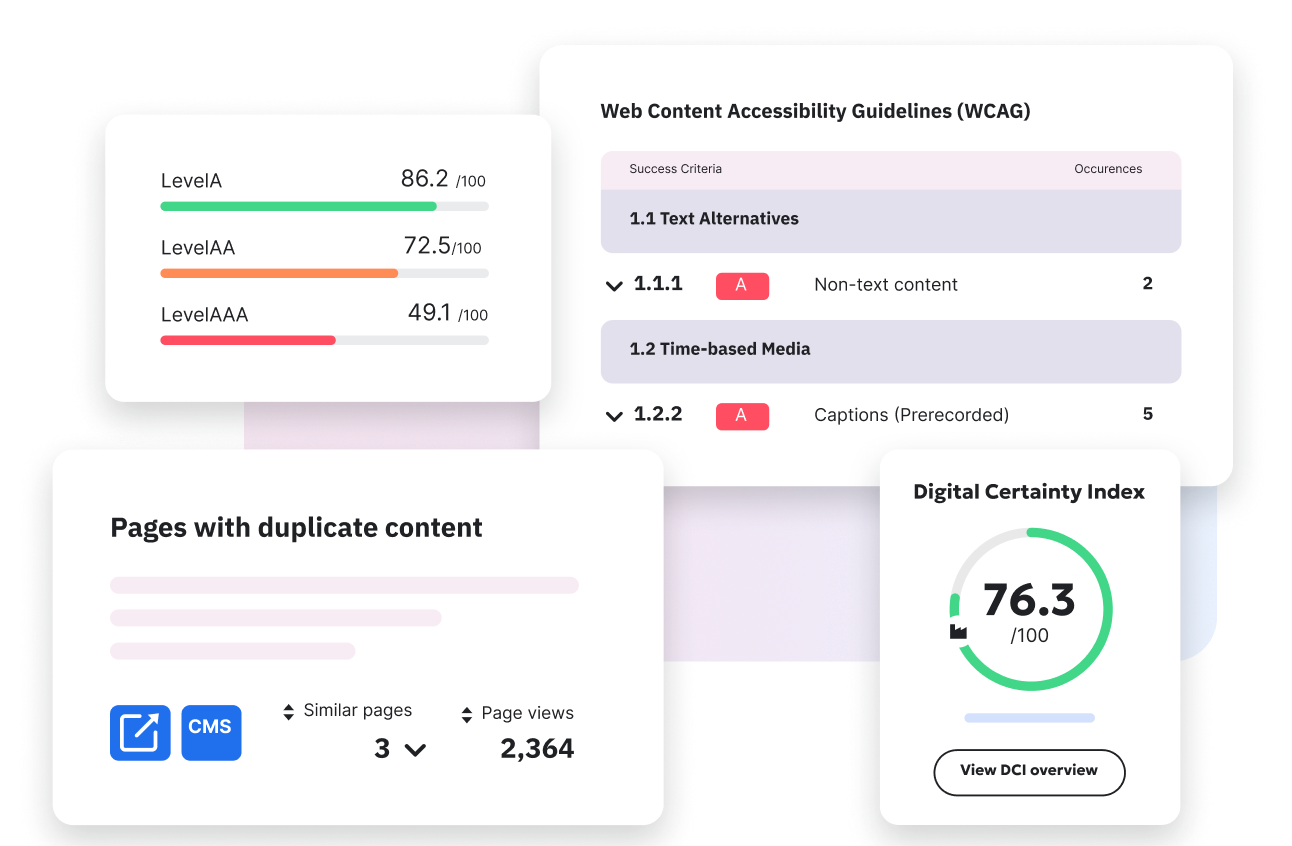
Our accessibility experts
Siteimprove's digital accessibility practice is robust and respected, partly because we're veterans in the field and partly because our accessibility experts are unmatched.

Christina Adams
CPACC, WAS, CPWA
Christina is manager of digital accessibility at Siteimprove and member of the International Association of Accessibility Professionals. She is a Certified Professional in Web Accessibility (CPWA), Certified Professional in Accessibility Core Competencies (CPACC) and Web Accessibility Specialist (WAS).

Tobias Christian Jensen
Tobias is senior technical program manager at Siteimprove and regularly leads workshops on digital accessibility training. An array of designers, developers, QA engineers, project managers, and business leaders across industries have relied on Tobias to guide them through the nuances and technicalities of digital accessibility and inclusive design.

Jean-Yves Moyen
As a Siteimprove principal software engineer, Jean-Yves is responsible for Siteimprove’s automated accessibility testing solution, including our Accessibility Checker. He also writes accessibility testing rules as part of the W3C community and has taught computer science at the University of Paris and the University of Copenhagen.

